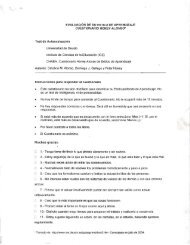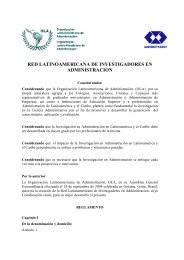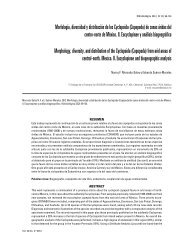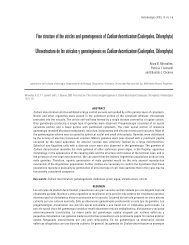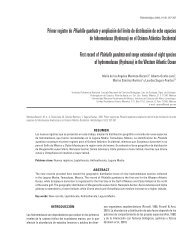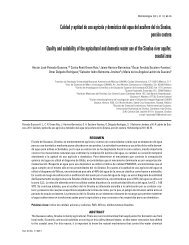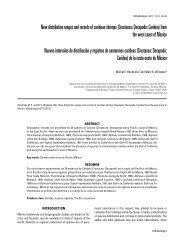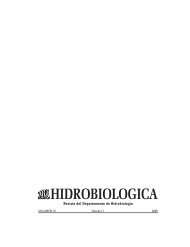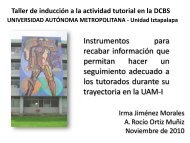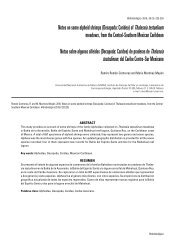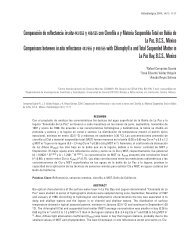Common reed (Phragmites australis ) harvest as a control method in ...
Common reed (Phragmites australis ) harvest as a control method in ...
Common reed (Phragmites australis ) harvest as a control method in ...
You also want an ePaper? Increase the reach of your titles
YUMPU automatically turns print PDFs into web optimized ePapers that Google loves.
<strong>Phragmites</strong> <strong>australis</strong> <strong>harvest</strong> <strong>as</strong> <strong>control</strong> <strong>method</strong> Hidrobiológica 2012, 22 (2): 125-131<br />
<strong>Common</strong> <strong>reed</strong> (<strong>Phragmites</strong> <strong>australis</strong> ) <strong>harvest</strong> <strong>as</strong> a <strong>control</strong> <strong>method</strong> <strong>in</strong> a Neotropical wetland <strong>in</strong><br />
Western México<br />
Cosecha de carrizo (<strong>Phragmites</strong> <strong>australis</strong> ) como método de <strong>control</strong> en un humedal del<br />
occidente de México<br />
Yazmín Escutia-Lara, 1 Sab<strong>in</strong>a Lara-Cabrera, 2 Mariela Gómez-Romero 3 and Roberto L<strong>in</strong>dig-Cisneros 3<br />
1 Doctorado Institucional en Cienci<strong>as</strong> Biológic<strong>as</strong>, Universidad Michoacana de San Nicolás de Hidalgo, Ciudad Universitaria, Morelia,<br />
Michoacán, 58030. México<br />
2 Laboratorio de Sistemática Molecular de Plant<strong>as</strong>, Facultad de Biología, Universidad Michoacana de San Nicolás de Hidalgo. Ciudad<br />
Universitaria, Morelia, Michoacán<br />
3 Laboratorio de Ecología de Restauración, Centro de Investigaciones en Ecosistem<strong>as</strong>, Universidad Nacional Autónoma de México<br />
Apartado Postal 27, Admón. 3, Santa María, Morelia, Michoacán, 58091. México<br />
e-mail: rl<strong>in</strong>dig@oikos.unam.mx<br />
Escutia-Lara Y., S. Lara-Cabrera, M. Gómez-Romero and R. L<strong>in</strong>dig-Cisneros. 2012. <strong>Common</strong> <strong>reed</strong> (<strong>Phragmites</strong> <strong>australis</strong>) <strong>harvest</strong> <strong>as</strong> a <strong>control</strong> <strong>method</strong> <strong>in</strong> a Neotropical<br />
wetland <strong>in</strong> Western México. Hidrobiológica 22(2): 125-131.<br />
ABSTRACT<br />
<strong>Common</strong> <strong>reed</strong> (<strong>Phragmites</strong> <strong>australis</strong>) h<strong>as</strong> <strong>in</strong>vaded wetlands worldwide and displaced native vegetation and wildlife.<br />
Control me<strong>as</strong>ures <strong>in</strong>clude herbicides, but their use can cause negative environmental impacts. An alternative is to<br />
<strong>harvest</strong> aerial biom<strong>as</strong>s. We tested <strong>harvest</strong> <strong>as</strong> a <strong>control</strong> for common <strong>reed</strong> <strong>in</strong> M<strong>in</strong>tzita spr<strong>in</strong>gs, Michoacán <strong>in</strong> Western<br />
Mexico. Results showed that <strong>harvest</strong> <strong>in</strong>cre<strong>as</strong>ed native plant species establishment, and that species richness varied<br />
with <strong>harvest</strong><strong>in</strong>g <strong>method</strong>. In plots where <strong>reed</strong> w<strong>as</strong> completely removed every two months, 9 native species established,<br />
the same number <strong>as</strong> <strong>in</strong> plots where all <strong>reed</strong> biom<strong>as</strong>s w<strong>as</strong> removed if at le<strong>as</strong>t one stem w<strong>as</strong> 2 m tall at the <strong>harvest</strong> date.<br />
When only <strong>reed</strong> stems 2m or taller where removed, 6 species established, where<strong>as</strong>, <strong>in</strong> <strong>control</strong> plots only three species<br />
established. Species composition correlated with <strong>harvest</strong><strong>in</strong>g <strong>method</strong> (ANOSIM, R=0.4514, p < 0.01). Harvest reduced<br />
resprout<strong>in</strong>g me<strong>as</strong>ured <strong>as</strong> stand<strong>in</strong>g biom<strong>as</strong>s (F (3,20) = 27, p < 0.000001). After one year of treatment, full removal plots had<br />
the lowest aerial dry biom<strong>as</strong>s (108 ± 15 g) followed by plots with full removal once a <strong>reed</strong> stem w<strong>as</strong> at le<strong>as</strong>t 2m tall (197<br />
± 81 g), followed by plots where only 2 m or taller stems were removed (593 ± 466 g) and <strong>control</strong> (3296 ± 232 g). Several<br />
<strong>reed</strong> plants died after the first year of the experiment. Although more trials and long term follow up are needed, our<br />
results suggest that <strong>harvest</strong> can be an efficient <strong>control</strong> <strong>method</strong> for <strong>reed</strong>-<strong>in</strong>fested wetlands <strong>in</strong> Western Mexico.<br />
Key words: Herbicide, native species, removal, restoration, water supply.<br />
RESUMEN<br />
El carrizo (<strong>Phragmites</strong> <strong>australis</strong>) <strong>in</strong>vade humedales a nivel mundial y desplaza a especies nativ<strong>as</strong>. Se <strong>control</strong>a con herbicid<strong>as</strong><br />
pero ésto puede causar impactos ambientales negativos. Una alternativa es la cosecha de la biom<strong>as</strong>a aérea,<br />
la cual se probó en los humedales del manantial de la M<strong>in</strong>tzita, Michoacán, en el occidente de México. La cosecha<br />
<strong>in</strong>crementa el establecimiento de especies nativ<strong>as</strong>, pero la riqueza de especies varía en función del método de cosecha.<br />
En parcel<strong>as</strong> en donde el carrizo se removió completamente cada dos meses, 9 especies nativ<strong>as</strong> se establecieron,<br />
el mismo número que en parcel<strong>as</strong> en donde se removió el carrizo cuando un tallo alcanzara los 2 m de altura. En<br />
parcel<strong>as</strong> en donde sólo se removieron tallos de dos metros de altura o más, se establecieron 6 especies, y sólo tres<br />
Vol. 22 No. 2 • 2012
126 Escutia-Lara Y. et al.<br />
en l<strong>as</strong> parcel<strong>as</strong> <strong>control</strong>. La composición de especies y la capacidad de retoñar del carrizo (F (3,20) = 27, p < 0.000001), se<br />
correlacionaron con el método de cosecha. Después de tan sólo un año, l<strong>as</strong> parcel<strong>as</strong> de remoción total presentaron la<br />
menor biom<strong>as</strong>a (108 ± 15 g) seguida por la remoción total cuando un tallo alcanzara los dos metros de altura (197 ± 81<br />
g), el tratamiento de remoción de tallos > 2 m (593 ± 466 g) y el <strong>control</strong> (3296 ± 232 g). Aunque se requieren ensayos de<br />
largo plazo en sitios <strong>in</strong>vadidos, estos resultados sugieren que la cosecha de carrizo puede ser una medida de <strong>control</strong><br />
eficiente en humedales <strong>in</strong>vadidos en el occidente de México.<br />
Palabr<strong>as</strong> clave: Especies nativ<strong>as</strong>, fuente de agua, herbicida, remoción, restauración.<br />
INTRODUCTION<br />
Plant <strong>in</strong>v<strong>as</strong>ions displace native species, alter key ecosystem functions<br />
and are a ma<strong>in</strong> cause of biodiversity decl<strong>in</strong>e (Mack et al.,<br />
2000). In wetlands, most <strong>in</strong>v<strong>as</strong>ions are fostered by human <strong>in</strong>duced<br />
changes <strong>in</strong> disturbance regimes and nutrient loads (Alpert et al.,<br />
2000; D´Antonio, 1993; Thompson et al., 2001). Once established,<br />
<strong>in</strong>v<strong>as</strong>ive plant species can alter environmental conditions and the<br />
<strong>in</strong>tensity and nature of biotic <strong>in</strong>teractions (D´Antonio & Vitousek,<br />
1992; Goldberg, 1990; Gordon, 1998; Vitousek et al., 1987), result<strong>in</strong>g<br />
<strong>in</strong> dramatic changes <strong>in</strong> the composition of native communities<br />
(Howard & Goldberg, 2001; Reader& Bonser, 1993).<br />
<strong>Common</strong> <strong>reed</strong> (<strong>Phragmites</strong> <strong>australis</strong> Cav. Tr<strong>in</strong> ex. Steud.) is a<br />
coarse perennial gr<strong>as</strong>s with a worldwide distribution. It is common<br />
<strong>in</strong> brackish and freshwater wetlands (Gle<strong>as</strong>on & Cronquist, 1963)<br />
especially <strong>in</strong> disturbed habitats along water bodies (Ailstock et<br />
al., 2001Marks et al., 1994; Saltonstall, 2002). It h<strong>as</strong> been suggested<br />
that this species turns <strong>in</strong>v<strong>as</strong>ive after human <strong>in</strong>duced changes<br />
<strong>in</strong> disturbance regimes, particularly changes <strong>in</strong> hydrological and<br />
nutrient regimes <strong>as</strong> well <strong>as</strong> sal<strong>in</strong>ity (Marks et al., 1994).<br />
Our experimental area, the M<strong>in</strong>tzita wetland complex, is located<br />
to the south of the city of Morelia, the capital of the state<br />
of Michoacán, México. The dom<strong>in</strong>ant species are cattail (Typha<br />
dom<strong>in</strong>gensis Presl.) and chairmaker’s bulrush (Schoenoplectus<br />
americanus (Pers.) Volkart ex Sch<strong>in</strong>z et Keller). Two major impacts<br />
on the wetlands are nitrogen <strong>in</strong>puts from the watershed<br />
and phosphorus rele<strong>as</strong>e from fires (Escutia-Lara et al., 2009). In<br />
recent years, P. <strong>australis</strong> h<strong>as</strong> <strong>in</strong>cre<strong>as</strong>ed its cover <strong>in</strong> the wetlands,<br />
displac<strong>in</strong>g native vegetation and alter<strong>in</strong>g hydrological regimes.<br />
Elsewhere, after <strong>in</strong>v<strong>as</strong>ion by P. <strong>australis</strong>, <strong>control</strong> me<strong>as</strong>ures were<br />
necessary to reduce its negative effects on natural wetland communities<br />
(Ailstock et al., 2001). The M<strong>in</strong>tzita spr<strong>in</strong>gs provides water<br />
for 300,000 <strong>in</strong>habitants of Morelia and conservation and restoration<br />
of the area is required, <strong>in</strong>clud<strong>in</strong>g P. <strong>australis</strong> <strong>control</strong>.<br />
<strong>Phragmites</strong> <strong>australis</strong> <strong>control</strong> h<strong>as</strong> been done by apply<strong>in</strong>g<br />
herbicides, mostly glyphosate, to affected are<strong>as</strong> (Back & Holomuzki,<br />
2008; Mozdzer et al., 2008; Turner & Warren, 2003), but<br />
use of glyphosate can have the undersired environmental impact<br />
of caus<strong>in</strong>g damage to non target species (Tsiu & Chu, 2007).<br />
Furthermore, glyphosate, is no longer considered completely<br />
safe for humans (Williams et al., 2000), because <strong>in</strong> recent studies<br />
it h<strong>as</strong> been suggested that long term exposure to some formulations<br />
might pose risks to human health (Romano et al., 2010).<br />
S<strong>in</strong>ce there are no official guidel<strong>in</strong>es or norms regard<strong>in</strong>g the<br />
use of herbicides <strong>in</strong> Mexican wetlands, and to avoid potential<br />
hazards to human populations, <strong>in</strong>formation on alternative <strong>reed</strong><br />
<strong>control</strong> <strong>method</strong>s is needed. This is especially true for wetlands<br />
that provide dr<strong>in</strong>k<strong>in</strong>g water, such <strong>as</strong> the M<strong>in</strong>tzita spr<strong>in</strong>gs, that provide<br />
up to 40% of the water of the city of Morelia. One alternative<br />
<strong>control</strong> me<strong>as</strong>ure is the removal of aerial biom<strong>as</strong>s, because elim<strong>in</strong>at<strong>in</strong>g<br />
the photosynthetic tissues of the plant can reduce posterior<br />
growth and spread of the species (Asaeda & Karunaratne,<br />
2000). In some are<strong>as</strong>, <strong>harvest</strong><strong>in</strong>g dur<strong>in</strong>g late summer h<strong>as</strong> no effect<br />
because reserves have already accumulated <strong>in</strong> plant tissues<br />
(Husak ,1978), where<strong>as</strong> <strong>harvest</strong><strong>in</strong>g after w<strong>in</strong>ter, when the plant<br />
h<strong>as</strong> already sprouted, can have a considerable effect because<br />
the plant h<strong>as</strong> low reserves (Karunaratne et al., 2004), also cont<strong>in</strong>uous<br />
<strong>harvest</strong><strong>in</strong>g can significantly reduce P. <strong>australis</strong> biom<strong>as</strong>s<br />
(Asaeda & Karunarante, 2000; Cizkova et al., 1996; Rajapakse et<br />
al., 2006; Van der Putten et al., 1997). Therefore, it is necessary to<br />
determ<strong>in</strong>e the optimal <strong>harvest</strong><strong>in</strong>g regime depend<strong>in</strong>g on regional<br />
conditions (Ostendorp, 1995; Rajapake et al., 2006). We compared<br />
the effect of four <strong>harvest</strong><strong>in</strong>g treatments <strong>in</strong> an area <strong>in</strong>vaded by P.<br />
<strong>australis</strong> with<strong>in</strong> M<strong>in</strong>tzita spr<strong>in</strong>gs on native species establishment,<br />
<strong>in</strong> order to <strong>as</strong>sess its management potential. Harvest<strong>in</strong>g treatments<br />
simulated exist<strong>in</strong>g practice. Traditionally, stems are used<br />
for handcrafts, <strong>as</strong> well <strong>as</strong> for other purposes. Usually, only stems<br />
2 m or taller are <strong>harvest</strong>ed (Gerritsen et al., 2009), but removal<br />
of all stems can also be observed (L<strong>in</strong>dig-Cisneros, pers. obs.).<br />
Therefore, <strong>harvest</strong> of <strong>reed</strong> aerial biom<strong>as</strong>s is socially accepted and<br />
provides an economic benefit.<br />
MATERIALS AND METHODS<br />
An area <strong>in</strong>vaded by P. <strong>australis</strong> w<strong>as</strong> selected with<strong>in</strong> the M<strong>in</strong>tzita<br />
wetlands (101°17’47” W, 19°38’43” N) for a <strong>harvest</strong><strong>in</strong>g experiment<br />
<strong>in</strong> 2009. The area h<strong>as</strong> been studied for the l<strong>as</strong>t 5 years by biannual<br />
plant composition sampl<strong>in</strong>g of 30, 1 m 2 permanent plots across the<br />
water depth gradient (Escutia-Lara et al., 2009). In our study site,<br />
P. <strong>australis</strong> grows all year round, although growth peaks dur<strong>in</strong>g<br />
summer and slows from October to February, when some leaves<br />
senesce and isolated stems die. With<strong>in</strong> a P. <strong>australis</strong> <strong>in</strong>vaded<br />
area where the water level did not varied significantly and w<strong>as</strong><br />
Hidrobiológica
<strong>Phragmites</strong> <strong>australis</strong> <strong>harvest</strong> <strong>as</strong> <strong>control</strong> <strong>method</strong> 127<br />
between soil level and 10 cm above it, all live and dead stems<br />
were removed at the beg<strong>in</strong>n<strong>in</strong>g of the 2009 grow<strong>in</strong>g se<strong>as</strong>on (February),<br />
cut stems were not submerged after removal. Four <strong>harvest</strong><strong>in</strong>g<br />
treatments were chosen: 1) <strong>harvest</strong><strong>in</strong>g all stems every<br />
60 days, 2) <strong>harvest</strong><strong>in</strong>g only stems that were 2 m or taller every<br />
60 days, 3) when one stem reached 2 m tall <strong>harvest</strong><strong>in</strong>g all stems<br />
every 60 days, 4) and a no <strong>harvest</strong><strong>in</strong>g treatment <strong>as</strong> <strong>control</strong> (Table<br />
1). Each treatment had 6 replicates, each <strong>in</strong> one 1 m 2 plot. Plots<br />
were placed at random leav<strong>in</strong>g 50 cm between plots. Plant species<br />
cover by plot w<strong>as</strong> recorded <strong>as</strong> percentage every 30 days, by<br />
divid<strong>in</strong>g each plot <strong>in</strong> square decimeters and record<strong>in</strong>g presenceabsence<br />
<strong>in</strong> each, for a year and P. <strong>australis</strong> stem height w<strong>as</strong> also<br />
evaluated by me<strong>as</strong>ur<strong>in</strong>g all stems <strong>in</strong> the plots.<br />
It w<strong>as</strong> dur<strong>in</strong>g June (120 days after the experiment started),<br />
at the beg<strong>in</strong>n<strong>in</strong>g of the ra<strong>in</strong>y se<strong>as</strong>on, that P. <strong>australis</strong> height (Fig.<br />
1) <strong>as</strong> well <strong>as</strong> cover started to diverge between treatments, for example,<br />
only 10 plots had more than 50% cover (Table 2). Also, two<br />
new species were recorded <strong>in</strong> the plots, Galium trifidium L. <strong>in</strong> 23<br />
plots and Polygonum hidropiperoides Michx. <strong>in</strong> two plots. In August<br />
(180 days after <strong>in</strong>itial <strong>harvest</strong>), Schoenoplectus americanus<br />
w<strong>as</strong> present <strong>in</strong> 6 plots and Carex comosa Booth w<strong>as</strong> recorded for<br />
the first time <strong>in</strong> one plot. In the follow<strong>in</strong>g months more species<br />
were recorded and most native species <strong>in</strong>cre<strong>as</strong>ed their cover,<br />
and se<strong>as</strong>onal changes <strong>in</strong> cover were also evident (Table 2). Us<strong>in</strong>g<br />
the October cover data, the month when more species were<br />
present at the end of the ra<strong>in</strong>y se<strong>as</strong>on, Bray-Curtis distances correlated<br />
with removal treatments (ANOSIM, R=0.4514, p=0.0099).<br />
<strong>Phragmites</strong> <strong>australis</strong> response to the experimental treatments<br />
w<strong>as</strong> analyzed by means of ANOVA with R software (R. Development<br />
Core Team, 2010), for all tests compliance with <strong>as</strong>sumptions<br />
of homogeneity of variances and normality w<strong>as</strong> checked. Species<br />
composition <strong>as</strong> affected by the treatments w<strong>as</strong> tested with<br />
ANOSIM on a Bray-Curtis distance matrix (Manly, 2000) us<strong>in</strong>g<br />
vegan <strong>in</strong> R (Oksanen et al., 2009). Comparison of species composition<br />
<strong>in</strong> <strong>reed</strong>-<strong>in</strong>vaded plots with the composition of not-<strong>in</strong>vaded<br />
plots with<strong>in</strong> the same water depth area of the wetlands w<strong>as</strong> done<br />
us<strong>in</strong>g the data of the permanent plots that have been monitored<br />
s<strong>in</strong>ce 2005 (Escutia-Lara et al., 2009) through a similarity analysis<br />
with Jaccard’s <strong>in</strong>dex for presence-absence data us<strong>in</strong>g MVSP<br />
software (Kovach Comput<strong>in</strong>g Services, 1998.)<br />
RESULTS<br />
Sixty days after <strong>in</strong>itial removal of <strong>Phragmites</strong> <strong>australis</strong> live and<br />
dead stems <strong>in</strong> february 2009, plots showed vigorous sprout<strong>in</strong>g<br />
of this species and a few <strong>in</strong>dividuals of other species. After 60<br />
additional days, 4 species were observed (Table 2): Hidrocotyle<br />
verticillata Thunb., Typha dom<strong>in</strong>gensis and Eupatorium rugosum<br />
Kunth., and <strong>in</strong> one plot an <strong>in</strong>dividual of Schoenoplectus americanus.<br />
Throughout the experiment only a few <strong>in</strong>dividuals of Hidrocotyle<br />
verticillata, Typha dom<strong>in</strong>gensis and Eupatorium rugosum<br />
were found <strong>in</strong> <strong>control</strong> plots.<br />
Figure 1. <strong>Phragmites</strong> <strong>australis</strong> mean stem height by treatment<br />
dur<strong>in</strong>g the duration of the experiment. Treatments were: (A)<br />
removal of all P. <strong>australis</strong> stems every two months, (B) removal<br />
of stems 2 m or taller every two months, (C) removal of all<br />
stems if at le<strong>as</strong>t one reached 2 m <strong>in</strong> height, and (D) <strong>control</strong>.<br />
Table 1. Number of plots <strong>harvest</strong>ed of each treatment at each <strong>harvest</strong><strong>in</strong>g<br />
<strong>in</strong>terval (<strong>in</strong> days after the experiment w<strong>as</strong> started).<br />
Treatments 60 days 120 days 180 days 240 days 300 days<br />
Control (D) 0 0 0 0 6<br />
A 6 6 6 6 6<br />
B 0 6 6 5 5<br />
C 0 6 6 4 1<br />
Figure 2. A comparison of experimental and permanent plots<br />
(evaluated from 2005 to 2008) us<strong>in</strong>g cluster agglomerative<br />
analysis b<strong>as</strong>ed on Jaccquard’s distance between plot’s species<br />
composition. Treatments <strong>in</strong> 2009 were: (A) removal of all<br />
P. <strong>australis</strong> stems every two months, (B) removal of stems 2 m<br />
or taller every two months, (C) removal of all stems if at le<strong>as</strong>t<br />
one reached 2 m <strong>in</strong> height, and (D) <strong>control</strong>.<br />
Vol. 22 No. 2 • 2012
128 Escutia-Lara Y. et al.<br />
Table 2. Cover (%) of <strong>Phragmites</strong> <strong>australis</strong> and native species present <strong>in</strong> the experimental plots at each <strong>harvest</strong> date after the <strong>in</strong>itial <strong>harvest</strong><br />
<strong>in</strong> February 2009. Treatments where: A) removal of all P. <strong>australis</strong> stems every two months, B) removal of stems 2 m or taller every two<br />
months, C) removal of all stems if at le<strong>as</strong>t one reached 2 m <strong>in</strong> height. Control plots not shown because only a few <strong>in</strong>dividuals of Hidrocotaly<br />
verticillata, Typha dom<strong>in</strong>gensis and Eupatorium rugosum were found all along the experiment.<br />
Days after <strong>in</strong>itial <strong>harvest</strong><br />
Species Treatment 60 90 120 150 180 210 240 270 300<br />
<strong>Phragmites</strong> <strong>australis</strong> Cav. Tr<strong>in</strong> ex. Steud. A 83 30 45 31 37 18 24 21 21<br />
B 84 55 42 43 42 43 44 45 45<br />
C 84 47 59 38 39 33 27 21 21<br />
Carex comosa Booth A 1 1<br />
Cyperus niger Ruiz et Pav.<br />
B 1 2 2 2 2 2<br />
C<br />
A<br />
B 1<br />
C 1 1<br />
Epilobium ciliatum Raf. A 1<br />
Eupatorium rugosum Kunth A 3 2 4 13 9 19 19<br />
B<br />
C<br />
B 3 3 4 6 5 13 13<br />
C 3 1 1 2 6 5 8 17 16<br />
Galium trifidium L. A 0 11 15 20 2 1 3 3<br />
B 0 12 15 19 3 2<br />
C 17 6 13 4 2 3 6 7<br />
Hidrocotyle verticillata Thunb. A 8 49 30 33 33 34 36 28 28<br />
B 8 21 34 20 29 27 24 18 18<br />
C 8 27 25 34 31 30 35 38 38<br />
Mimulus glabratus Kunth A 1 3 3<br />
Poaceae 1<br />
B 1 2 2<br />
C 3<br />
A<br />
B 1 1<br />
Poaceae 2 A 1<br />
C<br />
B 1 1<br />
Polygonum hydropiperoides Michx. A 2 2 3 3 6 5 5<br />
C<br />
B 2 2 1 2 4 2 2<br />
C 1 4 3 3 6 3 3<br />
Rorippa palustris (L.) Besser A 1 1 3<br />
B 2 1 2<br />
C 1 1 1<br />
Schoenoplectus americanus (Pers.) Volkart ex Sch<strong>in</strong>z et R. Keller A 1 3 4<br />
B 2 3<br />
Typha dom<strong>in</strong>gensis Pers. A 5 11 8 13 22 32 22 18 18<br />
C<br />
B 5 12 8 13 18 19 18 15 15<br />
C 5 9 8 8 18 26 21 14 14<br />
Hidrobiológica
<strong>Phragmites</strong> <strong>australis</strong> <strong>harvest</strong> <strong>as</strong> <strong>control</strong> <strong>method</strong> 129<br />
A comparison of experimental and permanent plots (evaluated<br />
from 2005 to 2008) us<strong>in</strong>g cluster agglomerative analysis<br />
b<strong>as</strong>ed on Jaccquard’s distance between plot’s species composition<br />
shows that removal treatments are closer to permanent plots<br />
evaluated <strong>in</strong> 2008 (Fig. 2). Control plots do not clustered with other<br />
treatment or permanent plots evaluated <strong>in</strong> 2005 and 2006 that are<br />
clustered together, because they share 16 of the 21 species present<br />
<strong>in</strong> the study area and are similar to plots evaluated <strong>in</strong> 2007<br />
because these plots share 12 species of 21 with those of 2005<br />
and 2006. At the end of the experiment, treatment A (complete removal)<br />
had 9 species and also treatment B (removal of all stems<br />
when at le<strong>as</strong>t one reached 2 m <strong>in</strong> height) be<strong>in</strong>g the most similar,<br />
and close to treatment C (only stems 2 m high or taller removed)<br />
plots that had 6 species .<br />
Trends <strong>in</strong> species composition were correlated with removal<br />
treatments because P. <strong>australis</strong> became less abundant <strong>in</strong> <strong>harvest</strong>ed<br />
treatments, <strong>in</strong> particular the treatment of full removal every<br />
60 days, and differences were found at the end of the removal<br />
experiment. Treatment A, full removal, had the lowest aerial dry<br />
biom<strong>as</strong>s of all treatments at the end of the experiment (108 ± 15<br />
g) followed by treatment C, full removal once a stem reached 2<br />
m <strong>in</strong> height (197 ± 81 g ), treatment B, where only 2 m or higher<br />
stems were removed (593 ± 466 g) and f<strong>in</strong>ally <strong>control</strong> (3296 ± 232<br />
g). The differences among treatments were significant (F (3,20) = 92,<br />
p < 0.000001). Differences <strong>in</strong> height among treatments (A = 83 ± 33<br />
cm, B = 225 ± 121 cm, C = 100 ± 80 cm, D = 437 ± 35 cm), were also<br />
significant (F (3,20) = 27, p < 0.000001). All P. <strong>australis</strong> plants died <strong>in</strong><br />
3 plots.<br />
DISCUSSION<br />
Harvest<strong>in</strong>g of <strong>Phragmites</strong> <strong>australis</strong> reduced sprout<strong>in</strong>g and aerial<br />
biom<strong>as</strong>s accumulation <strong>as</strong> other experiments have shown (Asaeda<br />
& Kurunaratne, 2000; Healy et al., 2007; Husak, 1978; Karunaratne<br />
et al., 2004; Rajapakse et al., 2006; van der Putten et al., 1997), and<br />
native species were able to colonize <strong>harvest</strong>ed plots. When compar<strong>in</strong>g,<br />
us<strong>in</strong>g a dendrogram, native species present <strong>in</strong> the experimental<br />
plots with those of the permanent plots with<strong>in</strong> the adjacent<br />
area of the wetland it w<strong>as</strong> noticeable that permanent plots from<br />
2005 to 2007 clustered together. Plots monitored <strong>in</strong> 2008 clustered<br />
with <strong>harvest</strong> treatments. The M<strong>in</strong>tzita wetlands have been subjected<br />
to <strong>in</strong>cre<strong>as</strong>ed human disturbance <strong>in</strong> the l<strong>as</strong>t decade chang<strong>in</strong>g<br />
species composition <strong>in</strong> our permanent plots (Escutia-Lara et<br />
al., 2009). In fact, permanent plots were not evaluated <strong>in</strong> 2009 because<br />
a provoked fire burned them just weeks before the scheduled<br />
sampl<strong>in</strong>g date. Harvest treatments, <strong>in</strong> particular full removal<br />
(A) and removal of stems 2 m <strong>in</strong> height or taller (B), clustered with<br />
plots evaluated <strong>in</strong> 2008, the closest sampl<strong>in</strong>g date of the permanent<br />
plots. Harvest<strong>in</strong>g of all P. <strong>australis</strong> stems when at le<strong>as</strong>t one<br />
of them reached 2 m <strong>in</strong> height (treatment C) w<strong>as</strong> not <strong>as</strong> close <strong>in</strong><br />
species composition to permanent plots, probably because the<br />
<strong>harvest</strong> date of a particular plot w<strong>as</strong> not necessarily the same<br />
<strong>as</strong> <strong>in</strong> treatment A. Therefore, the amounts of biom<strong>as</strong>s removed<br />
were more variable, <strong>as</strong> reflected <strong>in</strong> the l<strong>as</strong>t <strong>harvest</strong> date, when<br />
this treatment w<strong>as</strong> the most variable of all.<br />
For management of P. <strong>australis</strong> <strong>in</strong> our study area, several<br />
conclusions can be reached. First, there is not optimal se<strong>as</strong>on<br />
for removal, unlike <strong>in</strong> other are<strong>as</strong> where this species is present<br />
(Asaeda et al., 2002; Asaeda & Karunaratne, 2000; Bjorndahl, 1985;<br />
Gryseels, 1989a; Gryseels, 1989b; Husak, 1978). Second, it is important<br />
to note that the area <strong>in</strong>tervened <strong>in</strong> this study w<strong>as</strong> small,<br />
nevertheless, because removal is done manually, damage to the<br />
soil would be m<strong>in</strong>imal even <strong>in</strong> larger projects. Also, <strong>in</strong> larger project<br />
where propagules might no be available plant<strong>in</strong>g of desired<br />
species might be needed.<br />
Third, although all <strong>harvest</strong> treatments allow native species<br />
to establish, species composition <strong>in</strong> <strong>harvest</strong>ed treatments that<br />
are similar to the traditional use of the species (Gerritsen et al.,<br />
2009) are more similar to the composition of the natural wetland.<br />
Therefore, <strong>harvest</strong><strong>in</strong>g can be an efficient <strong>control</strong> <strong>method</strong> of this<br />
species <strong>in</strong> <strong>in</strong>fested wetlands <strong>in</strong> Western Mexico because local<br />
human populations already use the resource follow<strong>in</strong>g a <strong>method</strong><br />
that can be adapted for <strong>control</strong>.<br />
ACKNOWLEDGEMENTS<br />
This work w<strong>as</strong> f<strong>in</strong>anced by the National Autonomous University<br />
of Mexico by grant PAPIIT IN203608 and by CONACYT grant SEP-<br />
CONACYT-2008-101335.<br />
REFERENCES<br />
Ailstock, M. S., C. M. Norman & P. J. Bushmann. 2001. <strong>Common</strong> Reed<br />
<strong>Phragmites</strong> <strong>australis</strong>: <strong>control</strong> and effects upon biodiversity <strong>in</strong> freshwater<br />
nontidal wetlands. Restoration Ecology 9: 49-59.<br />
Alpert, P., E. Bone & C. Holzapfel. 2000. Inv<strong>as</strong>iveness, <strong>in</strong>v<strong>as</strong>ibility and the<br />
role of environmental stress <strong>in</strong> the spread of non-native plants. Perspectives<br />
<strong>in</strong> Plant Ecology Evolution and Systematics 3: 52-66<br />
Asaeda, T. & S. Karunaratne. 2000. Dynamic model<strong>in</strong>g of the growth of<br />
<strong>Phragmites</strong> <strong>australis</strong>: model description. Aquatic Botany 67: 301-<br />
318.<br />
Asaeda, T., L. H. Nam, P. Hietz, N. Tanaka & S. Karunaratne. 2002. Se<strong>as</strong>onal<br />
fluctuations <strong>in</strong> live and dead biom<strong>as</strong>s of <strong>Phragmites</strong> <strong>australis</strong> <strong>as</strong> described<br />
by a growth and decomposition model: implications of duration<br />
of aerobic conditions for litter m<strong>in</strong>eralization and sedimentation.<br />
Aquatic Botany 73: 223-239.<br />
Back, C. I. & J. R. Holomuzki. 2008. Long-term spread and <strong>control</strong> of <strong>in</strong>v<strong>as</strong>ive,<br />
common <strong>reed</strong> (<strong>Phragmites</strong> <strong>australis</strong>) <strong>in</strong> Sheldon Marsh, Lake<br />
Erie. Ohio Journal of Science 108: 108-112.<br />
Vol. 22 No. 2 • 2012
130 Escutia-Lara Y. et al.<br />
Bjorndahl, G. 1985. Influence of w<strong>in</strong>ter <strong>harvest</strong> on stand structure and<br />
biom<strong>as</strong>s production of the common <strong>reed</strong>, <strong>Phragmites</strong> <strong>australis</strong> (Cav.)<br />
Tr<strong>in</strong>. ex Steud. <strong>in</strong> Lake Takern, Southern Sweden. Biom<strong>as</strong>s 7: 303-<br />
319.<br />
Cizkova, H., J. A. Strand & J. Lukavska. 1996. Factors <strong>as</strong>sociated with<br />
<strong>reed</strong> decl<strong>in</strong>e <strong>in</strong> an eutrophic fishpond, Rozˇmberk (South Bohmemia,<br />
Czech Republic). Folia Geobotanica 31: 111-118.<br />
D’Antonio, C. M. & P. M. Vitousek. 1992. Biological <strong>in</strong>v<strong>as</strong>ions by exotic<br />
gr<strong>as</strong>ses, the gr<strong>as</strong>s/fire cycle, and global change. Annual Review <strong>in</strong><br />
Ecology and Systematics 23: 63-87.<br />
D’Antonio, C. M. 1993. Mechanisms <strong>control</strong>l<strong>in</strong>g <strong>in</strong>v<strong>as</strong>ion of co<strong>as</strong>tal plant<br />
communities by the alien succulent Carpobrotus edulis. Ecology 74:<br />
83-95.<br />
Escutia-Lara, Y., S. Lara-Cabrera & R. L<strong>in</strong>dig-Cisneros. 2009. Efecto del<br />
fuego y d<strong>in</strong>ámica de l<strong>as</strong> hidrófit<strong>as</strong> emergentes en el humedal de la<br />
M<strong>in</strong>tzita, Michoacán, México. Revista Mexicana de Biodiversidad<br />
80: 771-778.<br />
Gerritsen, P. R. W., C. Ortiz-Arrona & R. González-Figueroa. 2009. Popular<br />
usage, tradition and exploitation of <strong>reed</strong>: a c<strong>as</strong>e study <strong>in</strong> the south<br />
co<strong>as</strong>t of Jalisco, Mexico. Economía, Sociedad y Territorio 9: 185-<br />
207.<br />
Gle<strong>as</strong>on, H. A. & A. Cronquist. 1963. Manual of v<strong>as</strong>cular plants of northe<strong>as</strong>tern<br />
United States and adjacent Canada. D. Van Nostrand Company,<br />
New York. 910 p.<br />
Goldberg, D. E. 1990. Components of resource competition <strong>in</strong> plant communities.<br />
In: Grace JB, Tilman D. (Eds.) Perspectives on plant competition.<br />
Academic Press. San Diego. pp. 27-49.<br />
Gordon, D. R. 1998. Effects of <strong>in</strong>v<strong>as</strong>ive, non-<strong>in</strong>digenous plant species on<br />
ecosystem processes: lessons from Florida. Ecological Applications<br />
8: 975-989.<br />
Gryseels, M. 1989a. Nature management experiments <strong>in</strong> a derelict <strong>reed</strong><br />
marsh. I. Effects of w<strong>in</strong>ter cutt<strong>in</strong>g. Biological Conservation 47: 171-<br />
193.<br />
Gryseels, M. 1989b. Nature management experiments <strong>in</strong> a derelict <strong>reed</strong><br />
marsh. II. Effects of summer mow<strong>in</strong>g. Biological Conservation 48:<br />
85-99.<br />
Healy, M. G., J. Newell & M. Rodgers. 2007. Harvest<strong>in</strong>g effects on biom<strong>as</strong>s<br />
and nutrient retention <strong>in</strong> <strong>Phragmites</strong> <strong>australis</strong> <strong>in</strong> a free-water surface<br />
constructed wetland <strong>in</strong> Western Ireland. Biology an Environment:<br />
Proced<strong>in</strong>gs of the Royal Irish Academy 107B: 139-145.<br />
Howard, T. G. & D. E. Goldberg. 2001. Competitive response hierarchies<br />
for germ<strong>in</strong>ation, growth, and survival and their <strong>in</strong>fluence on abundance.<br />
Ecology 82: 979-990.<br />
Husak, S. 1978. Control of <strong>reed</strong> and <strong>reed</strong> mace stands by cutt<strong>in</strong>g. Ecological<br />
Studies 28: 404-408.<br />
Karunaratne, S., T. Asaeda & K. Yutani. 2004. Shoot regrowth and age-specific<br />
rhizome storage dynamics of <strong>Phragmites</strong> <strong>australis</strong> subjected to<br />
summer <strong>harvest</strong><strong>in</strong>g. Ecological Eng<strong>in</strong>eer<strong>in</strong>g 22: 99-111.<br />
Kovach Comput<strong>in</strong>g Services. 1998. MVSP. Versión 3.01.<br />
Mack, R. N., D. Simberloff, W. M. Lonsdale, H. Evans, M. Clout & F. A.<br />
Bazzaz. 2000. Biotic <strong>in</strong>v<strong>as</strong>ions: causes, epidemiology, global consequences<br />
and <strong>control</strong>. Ecological Applications 10: 689-710.<br />
Marks, M., B. Lap<strong>in</strong> & J. Randall. 1994. <strong>Phragmites</strong> <strong>australis</strong> (P. communis):<br />
Threats, management, and monitor<strong>in</strong>g. Natural Are<strong>as</strong> Journal<br />
14: 285-294.<br />
Manly, B. F. J. 2000. Multivariate statistical <strong>method</strong>s: a primer. Second<br />
Edition. Chapman and Hall, CRC Press, Boca Raton, Florida. 224 p.<br />
Mozdzer, T. J., C. J. Hutto, P. A. Clarke & D. P. Field. 2008. Efficacy of<br />
imazypar and glyphosate <strong>in</strong> the <strong>control</strong> of non-native <strong>Phragmites</strong><br />
<strong>australis</strong>. Restoration Ecology 16: 221-224.<br />
Oksanen, J., R. K<strong>in</strong>dt, P. Legendre, B. O’Hara, G. L. Simpson, P. Solymos,<br />
M. Henry, H. Stevens & H. Wagner. 2009. Vegan: Community Ecology<br />
Package. R package version 1.15-4. Available <strong>in</strong>: http://CRAN.R-project.org/package=vegan<br />
(downloaded June 2010).<br />
Ostendorp, W. 1995. Effect of management on the mechanical stability<br />
of lakeside <strong>reed</strong>s <strong>in</strong> Lake Constance-Untersee. Acta Oecologica 16:<br />
277-294.<br />
R. Development Core Team. 2010. R: A language and environment for statistical<br />
comput<strong>in</strong>g. R Foundation for Statistical Comput<strong>in</strong>g. Vienna,<br />
Austria. ISBN 3.900051-07-0.<br />
Rajapakse, L., T. Asaeda, D. Williams, R. Roberts & J. Manatunge. 2006.<br />
Influence of water depth on the nutrient dynamics of Eleocharis<br />
sphacelata and litter accumulation <strong>in</strong> deep water lead<strong>in</strong>g to eutrophication.<br />
Chemical Ecology 22: 47-57.<br />
Reader, R. J. & S. P. Bonser. 1993. Control of plant frequency on an environmental<br />
gradient: effects of abiotic variables, neighbours, and<br />
predators on Poa pratensis and Poa compressa (Gram<strong>in</strong>eae). Canadian<br />
Journal of Botany 71: 592-597.<br />
Romano, R. M., M. A. Romano, M. M. Bernardi, P. V. Furtado & C. A.<br />
Oliveira. 2010. Prepubertal exposure to commercial formulation of<br />
the herbicide glyphosate alters testosterone levels and testicular<br />
morphology. Archives of Toxicology 84: 309-317.<br />
Saltonstall, K. 2002. Cryptic <strong>in</strong>v<strong>as</strong>ion by a non-native genotype of the<br />
common <strong>reed</strong> <strong>Phragmites</strong> <strong>australis</strong>, <strong>in</strong>to North America. Proceed<strong>in</strong>gs<br />
of the National Academy of Sciences 99(4): 2445-2449.<br />
Thompson, K., J. G. Hodgson, J. P. Grime & M. J. W. Burke. 2001. Plant traits<br />
and temporal scale: evidence from a 5-year <strong>in</strong>v<strong>as</strong>ion experiment us<strong>in</strong>g<br />
native species. Journal of Ecology 89: 1054-1060.<br />
Hidrobiológica
<strong>Phragmites</strong> <strong>australis</strong> <strong>harvest</strong> <strong>as</strong> <strong>control</strong> <strong>method</strong> 131<br />
Tsui, M. T. K. & L. M. Chu. 2007. Environmental fate and non-target<br />
impact of glyphosate-b<strong>as</strong>ed herbicide (Roundup®) <strong>in</strong> a subtropical<br />
wetland. Chemosphere 71: 439-446.<br />
Turner, R. E. & R. S. Warren. 2003. Valuation of cont<strong>in</strong>uous and <strong>in</strong>termittent<br />
<strong>Phragmites</strong> <strong>control</strong>. Estuaries 26: 618-623.<br />
Van der Putten, W. H., B. A. M. Peters & M. S. Van der Berg. 1997. Effects of<br />
litter on substrate conditions and growth <strong>in</strong> emergent macrophytes.<br />
New Phytologist 135: 527-537.<br />
Vitousek, P. M., L. R. Walke, L. D. Whittacker, D. Mueller-Dombois & P. A.<br />
Matson. 1987. Biological <strong>in</strong>v<strong>as</strong>ion by Myrica faga alters ecosystem<br />
development <strong>in</strong> Hawaii. Science 238: 802–804.<br />
Williams, G. M., R. Kroes & I. C. Munro. 2000. Safety evaluation and risk<br />
<strong>as</strong>sessment of the herbicide Roundup and its active <strong>in</strong>gredient,<br />
glyphosate, for humans. Regulatory Toxicology and Pharmacology<br />
31: 117-165.<br />
Recibido: 06 de junio de 2011.<br />
Aceptado: 04 de mayo de 2012.<br />
Vol. 22 No. 2 • 2012



